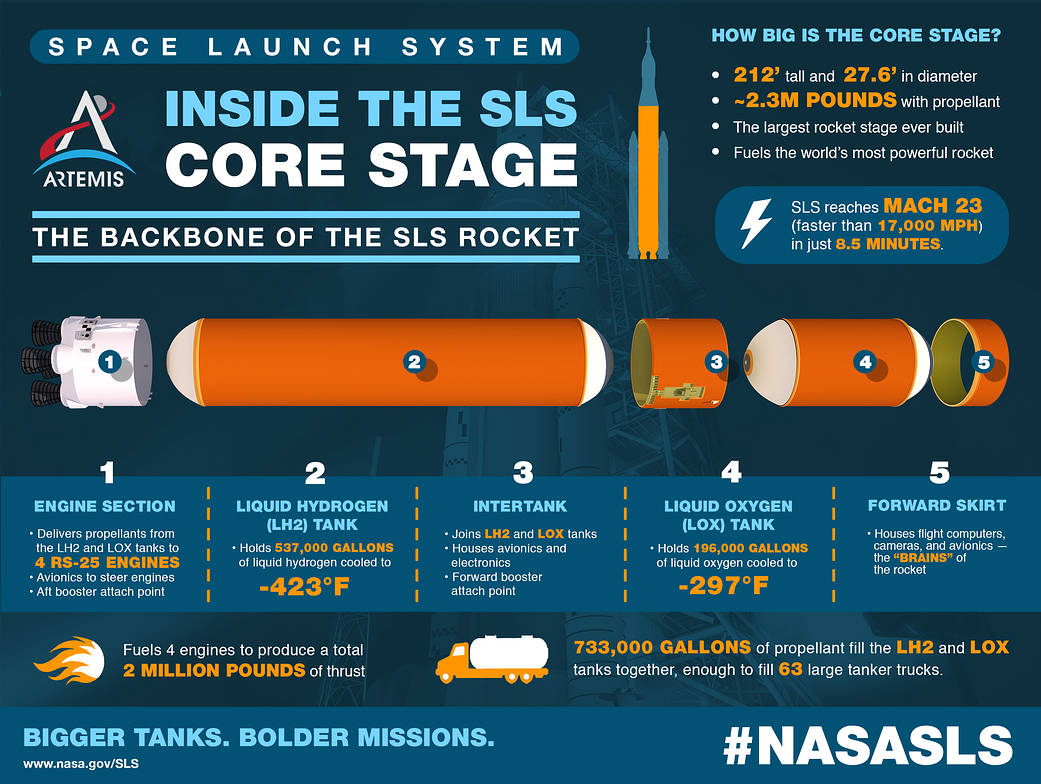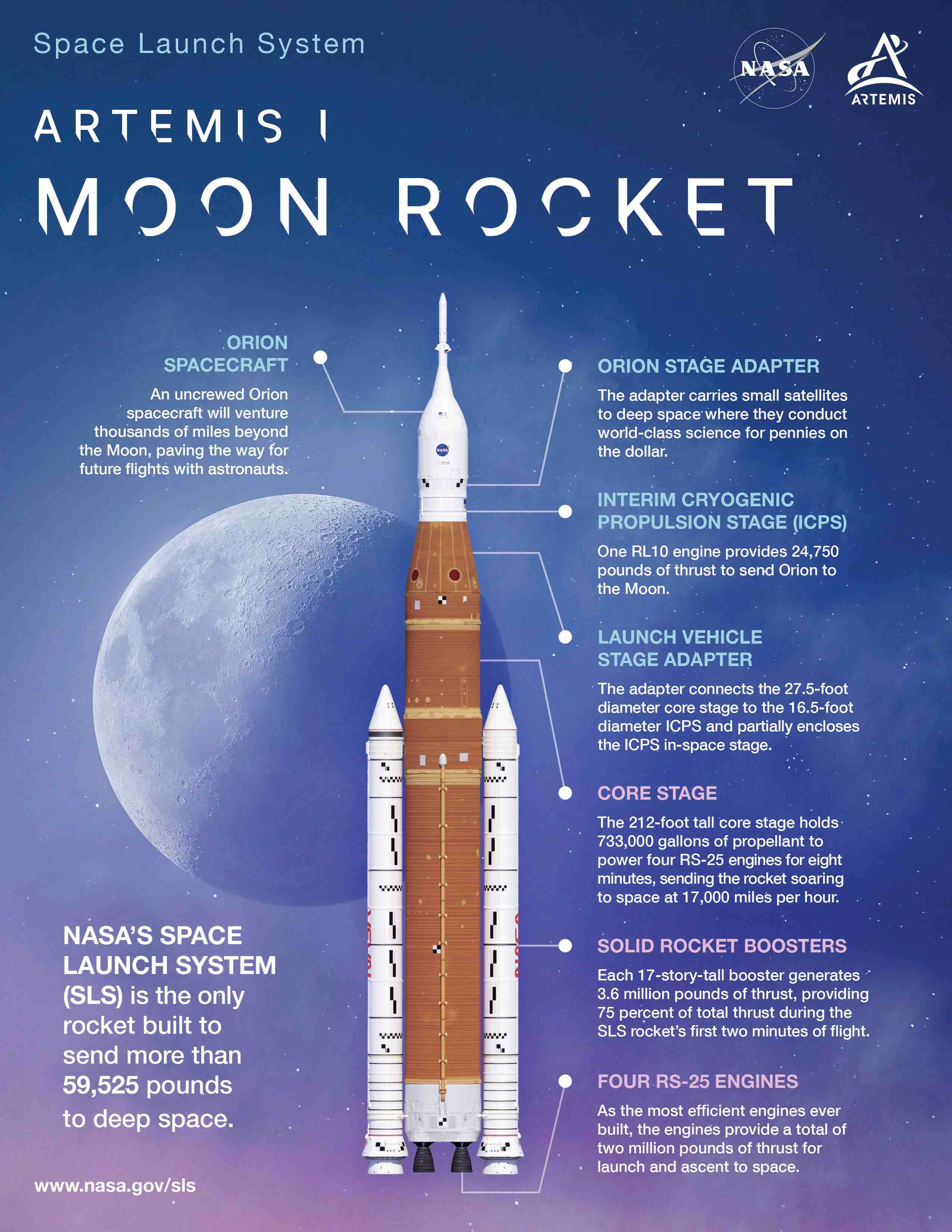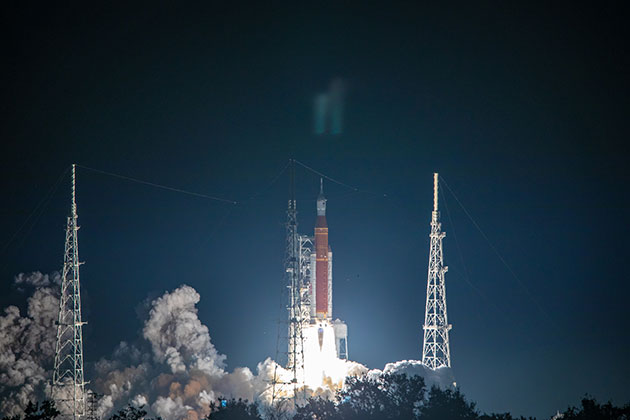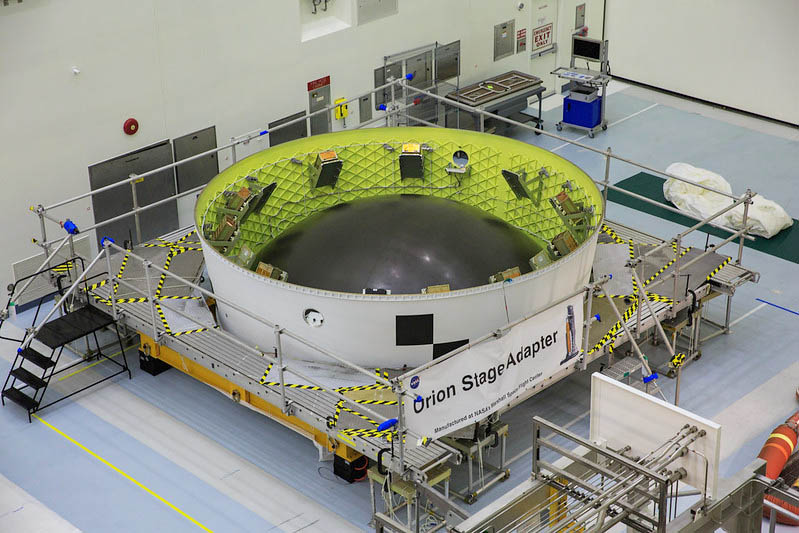Artemis Goes to the Moon!

NASA’s Space Launch System takes off (Boeing/John Grant)

NASA’s Space Launch System takes off (Boeing/John Grant)
How does this align with my curriculum?
Learn about NASA’s Space Launch System, which includes the Boeing-built Core Stage, and how it got Orion to the Moon and back again.
It’s been 50 years since humankind set foot on the lunar surface. The last time was during the Apollo 17 mission on December 7, 1972. The next chapter in deep space exploration and scientific discovery is NASA’s Artemis program. This program is focused on returning humans to the Moon and preparing to go to Mars and beyond.
Did you know?
During the Apollo 17 mission, the Boeing-built Lunar Roving Vehicle (LRV) drove about 30 km on the Moon’s surface.
The Missions
- Artemis I was an uncrewed mission and test flight of NASA’s Space Launch System (SLS) rocket and Orion spacecraft. It took place between November 16 and December 11, 2022.
- Artemis II will be a crewed flight that sends astronauts around the Moon and back to Earth.
- Artemis III will bring the first woman and the first person of colour to the surface of the Moon.
Did you know?
In Greek mythology, Artemis is Apollo’s twin sister and the goddess of the Moon.
Let’s look at each mission in more detail.
Artemis I
On November 16, 2022, at 1:47 a.m. Eastern Time, the Artemis I mission successfully began at the Kennedy Space Center in Florida, USA. One of the main purposes of the mission was to test the Space Launch System (SLS) rocket and the Orion spacecraft.
From top to bottom, the SLS rocket is made up of:
- the Interim Cryogenic Propulsion Stage (ICPS);
- The Interim Cryogenic Propulsion Stage (ICPS) stands about 13.7 metres tall and is about 5 metres in diameter. It is powered by one RL10 engine that sends the Orion spacecraft on the right path to the Moon. For the Artemis I mission, one end of the ICPS was attached to the Orion stage adapter and held 10 small satellites, called CubeSats, which were released into lunar orbit. The other end is attached to the Core Stage by the Launch Vehicle Stage Adapter.
- the Launch Vehicle Stage Adapter (LVSA);
- The cone-shaped LVSA connects the narrower ICPS to the wider Core Stage below it.
- the Core Stage built by Boeing together with industry partners;
- The Core Stage is the largest rocket stage ever built! It fuels the world’s most powerful rocket. It stands almost 65 metres tall and is about 8.5 metres in diameter.

Inside the core stage infographic (Source: NASA).
Image - Text Version
Shown is a colour infographic showing the parts inside the core stage of the Artemis I moon rocket.
The background is dark blue with orange and teal text in light blue boxes. The title of the infographic, "Core Stage 101*," is in the top left corner. A subtitle reads "*Or, what you need to know about the Space Launch System Core Stage, the backbone of the rocket." Below is another short section. This is labelled "Intertank."
To the right is a diagram labelled "Inside the Core Stage". This is a pale blue, rocket-shaped silhouette. Areas inside are labelled with white text. Starting from the top, a short orange section is labelled "Forward Skirt." Below is a longer, oval section labelled "Liquid Oxygen (LOX) Tank." Below, the largest section - a long orange oval - is labelled "Liquid Hydrogen (LH2) Tank." A square grey section at the bottom of the rocket is labelled "Engine Section."
To the right is a list of facts titled "How Big is the SLS Core Stage?" Below, four bullet points read:
- 212 feet tall and 25.6 feet in diameter
- About 2.3 million pounds with propellant
- The largest rocket stage ever built
- Fuels the world's most powerful rocket
Below is a pale blue text box titled "A Fast Ride!", with a white lightening bolt on the left side. Text below reads, "The SLS reaches MACH 23 (faster than 17 000 miles per hour) in just 8.5 minutes."
A numbered illustration of the five parts of the core stage is spread across the centre of the image. Below, a long, pale blue rectangle is divided into five numbered, corresponding sections.
Starting on the left, a white cylinder with three black cones attached to the end is labelled 1. The text below is titled "Engine Section." The bullet points below read:
- Delivers propellants from the LH2 and LOX to 4 RS-25 engines
- Avionics to steer engines
- Alt booster attach points
To the right, a long orange cylinder with rounded white ends is labelled 2. The text below is titled "LH2 Tank." The bullet points below read:
- Holds 37 000 gallons of hydrogen cooled to -423 degrees Fahrenheit
To the right is a short, hollow orange cylinder labelled 3. The text below is titled "Intertank." The bullet points below read:
- Joins LH2 and LOX tanks
- Houses avionics and electronics
- Forward booster attach point
3
To the right, medium length orange cylinder with rounded white ends is labelled 4. The text below is titled LOX Tank. The bullet points below read:
- Holds 196 000 gallons of liquid oxygen cooled to -297 degrees Fahrenheit
The final section on the right is a thin orange ring labelled 5. The text below is titled "Forward Skirt." The bullet points below read:
- Houses flight control computers, cameras and avionics - the "brains" of the rocket
Below the numbered sections is a long, darker blue section. On the left is a small illustration of a bright orange flame. The text next to it reads, "Fuels 4 engines to produce a total 2 million pounds of thrust." On the right is a small orange and white illustration of a tanker truck. The text next to it reads, "730 000 gallons of propellant fill the LH2 and LOX tanks together, enough to fill 63 large tanker trucks."
Along the bottom edge of the infographic is the following text: "www.nasa.gov/sls; Bigger tanks. Bolder missions. #nasasls."
- two solid rocket boosters;
- The 2 boosters on the SLS are the most powerful solid rocket boosters ever built for a rocket! Each booster stands almost 54 metres tall and produces over 1.5 million kilograms of thrust. The 2 solid rocket boosters combined produce more than 75% of the total thrust for the SLS rocket during the first 2 minutes of flight.
- and four RS-25 engines.
- The 4 RS-25 engines are part of the engine section of the Core Stage. Each of the 4 engines weigh about 3,600 kg and are about the size of a small car! Each engine produces over 225,000 kilograms of thrust.
Together the SLS rocket and Orion spacecraft stand about 98 metres tall. When full of fuel, they weigh more than 2.3 million kilograms!
The SLS core stage contains the propellant. The propellant is the fuel used by the rocket engines. When full, the core stage contains about 2.8 million litres of liquid oxygen and liquid hydrogen. As the most powerful rocket in the world, SLS produces about 4 million kilograms of thrust when it lifts off.

Infographic of the parts of the Artemis I rocket system (Source: NASA).
Image - Text Version
Shown is a labelled, colour illustration of the Artemis 1, against a background of the moon in space.
A small blue title in the top left corner of the image reads, "Space Launch System." Below, a larger title in white font reads, "Artemis 1 Moon Rocket." In the lower left corner a block of text reads, "NASA's space launch system (SLS) is the only rocket built to send more than 59 525 pounds to deep space.
A detailed illustration of the rocket stretches from the top to the bottom of the illustration. Its parts are labelled with lines leading to short paragraphs of information in white text.
Starting at the top, a white, pointed, cone-shaped section is labelled with the title "Orion Spacecraft." The text below reads, "An uncrewed Orion spacecraft will venture thousands of miles beyond the Moon, paving the way for future flights with astronauts."
Below, a white cylinder marked with four, small black squares is labelled "Orion Stage Adapter." The text below reads, "The adapter carries small satellites to deep space where they conduct world-class science for pennies on the dollar."
Below, a short, white cylindrical section is labelled "Interim Cryogenic Propulsion Stage (ICPS)." The text below reads, "One RL10 engine provides 24 750 pounds of thrust to send Orion to the Moon."
Below, a brown cylinder with a wide base and sloped walls is labelled, "Launch Vehicle Stage Adapter." The text below reads, "The adapter connects the 27.5-foot diameter core stage to the 16.5-foot diameter ICPS and partially encloses the ICPS in-space stage."
Below, a brown cylinder with beige rings near the top and bottom edges is labelled, "Core Stage." The text below reads, "The 212-foot tall core stage holds 733 000 gallons of propellant to power 4 RS-25 engines for eight minutes, sending the rocket soaring to space at 17 000 miles per hour."
Below, on either side of a long brown cylinder, two thin white cylinders with pointed tops are labelled, "Solid Rocket Boosters." The text below reads, "Each 17-storey-tall booster generates 3.6 million pounds of thrust, providing 75 percent of total thrust during the SLS rocket's first two minutes of flight."
At the bottom of the structure, small black cones are labelled, "Four RS-25 Engines." The text below reads, "As the most efficient engines ever built, the engines provide a total of two million pounds of thrust for launch and ascent to space."
The moon is large in the background. Half dark blue and half light. The space around goes from dark blue at the top, to purple at the bottom. It is misted with pale gases and sprinkled with tiny stars.
The Flight

The Space Launch System rocket lifts off from Launch Complex 39B at NASA's Kennedy Space Center (Source: Boeing/John Grant)
Image - Text Version
Shown is a colour photograph of a rocket with flames coming out of its base, surrounded by billowing smoke.
The rocket is brown with long white cylinders on each side, and a long, pointed tip. There are three pointed towers made from metal bars. One is just in front of the rocket, and the others are some distance to either side.
The night sky above is dark blue. Two thick, bright flames light up the area around the base of the rocket. Large grey clouds of smoke roll around the flames and over to the left edge of the image.
Then, after about eight minutes, the propellant in the core stage burned up and the four engines shut off. We call this the Main Engine Cutoff. After the engines shut off, the core stage separated from the Orion part of the launch system. At just eight-and-a-half minutes after liftoff, the Orion capsule was safely placed into orbit using the Interim Cryogenic Propulsion Stage (ICPS). At that moment, the SLS core stage’s job was complete!
Orion spreads its wings (2020) from the European Space Agency (2:28 min.)
In this video, see how the solar arrays unfold.
About 1 hour and 20 minutes after liftoff, the engine on the ICPS started the first of two burns to put Orion on the right course. A burn is when thrust is applied in order to change the velocity of the spacecraft. The second burn took about 18 minutes to complete.
Finally, in just under 2 hours from liftoff, the ICPS separated from Orion. This allowed the Orion capsule to accelerate to more than 40,000 kilometers per hour. At this speed, it was able to escape Earth’s gravity and be on its way to the Moon.

Shoebox-sized cubesats line the interior of the Orion stage adapter (Source: NASA [public domain] via Flickr).
Image - Text Version
Shown is a colour photograph of a wide cylinder on a raised platform.
The inside wall of the cylinder is neon green with a triangular pattern. Twelve screens are mounted all the way around the wall. The floor inside the cylinder is a black, rounded dome. The outside wall is smooth and white, marked with two small squaresat the front.
After nearly 26 days, Artemis I successfully completed its mission on December 11, 2022 when the Orion capsule splashed down in the Pacific Ocean.
Did you know?
A “Moonikin” mannequin named Campos along with 2 mannequin torsos made up the Orion ‘crew’ to collect data for future human spaceflight.
Artemis II and Beyond
A Boeing-built Core Stage will also be used for the Artemis II mission. For this mission, Canada will even send an astronaut aboard the Orion! This will be one of two rides that the Canadian Space Agency will receive aboard the Orion due to their contribution of a robotic arm, called Canadarm3.
Let’s Talk Science appreciates the work and contributions of Susan Higashio Weinreich from Boeing Canada in the development of this Backgrounder.
As a leading global aerospace company, Boeing develops, manufactures and services commercial airplanes, defense products and space systems for customers in more than 150 countries. As a top U.S. exporter, the company leverages the talents of a global supplier base to advance economic opportunity, sustainability and community impact. Boeing's diverse team is committed to innovating for the future, leading with sustainability, and cultivating a culture based on the company's core values of safety, quality and integrity. Join our team and find your purpose at boeing.com/careers.
Learn More
Artemis sends mini satellites on deep-space missions (November 21, 2022)
Learn more about the cubesats that were sent into orbit.
Boeing Educational Inspiration – Space Exploration
This page has information and hands-on activities related to the Artemis missions.
Boeing Space Launch System
Learn more about the Boeing Space Launch System.
NASA Artemis
Keep up to date with the Artemis program on this NASA web page.
NASA Artemis I
Learn more about the Artemis I mission from NASA.
References
Boeing (Nov 16, 2022). Liftoff! Space Launch System powers historic lunar mission.
Boeing (Dec 11, 2022). NASA's Artemis I Mission Sees Successful Completion.
Boeing (Dec 12, 2022). Splashdown! Artemis I capsule returns to Earth.
Boeing (n.d.). Boeing In Space.
Boeing (n.d.). NASA SLS Rocket Science in 60 Seconds.
Canadian Space Agency (Dec 11, 2022). Statement from Canadian Space Agency President Lisa Campbell on the successful completion of the Artemis I mission.
Canadian Space Agency (n.d.). Canada's Role in Moon Exploration.
NASA (Nov 16, 2022). Artemis I Launch to the Moon [Video]. YouTube.
NASA (Jul 1, 2021). Artemis Program.
